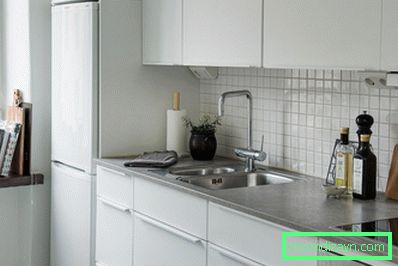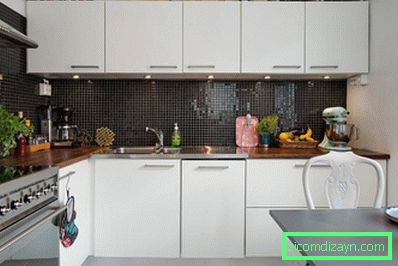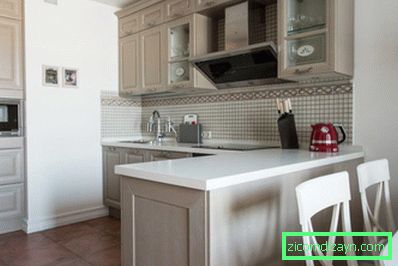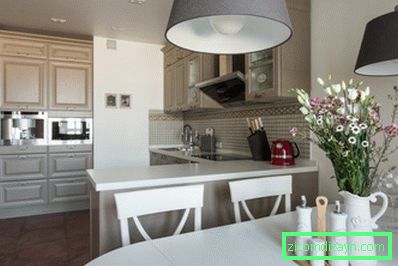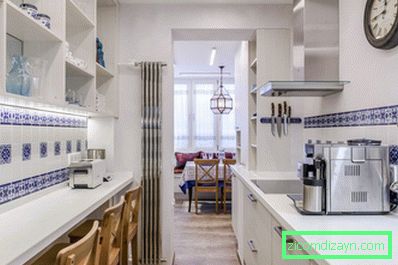How to choose a tile for an apron
The kitchen apron of tiles has no equal in practically everything: after all, it is durable, and easy to care for, it is not afraid of fire, moisture, alkalis, acids or UV rays, and at the same time it can be quite inexpensive. In addition, due to the variety of formats and textures, as well as the ways of laying tiles, the design of the apron becomes enormous.
- The disadvantages of the tile apron include only the presence of seams that complicate cleaning and require renovation of the grout every 2-5 years, as well as a very troublesome and dirty process of installation and dismantling.
Our memo for the buyer and a selection of 50 photo interiors will help you choose the perfect tile for the apron, determine its format, design and way of laying.
12 Nuances of Tile Selection for an Apron
1. Not all tiles are practical
The apron of tiles can be very unpretentious, and can, on the contrary, deliver a lot of trouble. First, because of the many seams, and secondly, because of the relief of the tile itself.
- To prevent this from happening, give preference to a smooth medium / large format tile.
It is also important that the tile has a moisture absorption mark of grade A, and preferably AA. Such a tile will withstand the attack of any cleaning products.
2. Semi-matt and matt tile is resistant to scratches, abrasion and chips, than glossy
Random cuts of an apron with a knife or, say, punches with a handle of a pot when it is moved along a plate, as well as cleaning with abrasives, matte and semi-mat tiles carry better than glossy. However, wall tiles are not floor tiles, and therefore, this recommendation can only be relevant for those who prepare often and actively.
3. It is desirable to choose a tile not too dark and not too light
White tiles are good for everyone, and in itself it is very practical, but because of the combination with light trowel, its seams have to be cleaned twice more carefully, and the fugue itself needs to be updated more often.
- If you are not ready to pay special attention to the seams of the white apron, we recommend either combining the white tiles with contrasting dark trowel (see photo below), or replace it with light gray or beige.

- If you still decided on the white tile and white grout, try to pick up materials so that the tile was a little darker or matched in tone with the seams.
What is bad is the dark apron? Unfortunately, it is very noticeable dust, stains, splashes of fat, stains from water. Particularly complex in the care of a dark glossy apron, as it leaves traces of fingers.

Black apron of glossy tiles looks beautiful, but, unfortunately, it is very visible even the smallest specks and fingerprints
4. Buy a tile with a margin of 10-15%
After calculating the necessary number of tiles for the apron of your parameters, be sure to add to this number 10-15%. This stock will fill the losses in case of battle, marriage, unsuccessful pruning, and also will allow to repair the apron in the future locally.
- Of course, before going to the store you need to know the size of the future apron. Most often its height is 60 cm, but if the owner / hostess of the kitchen has a small height, then the apron is more convenient to make as low - from 48 cm. Please note that the tiles should go for a couple of centimeters under the hinged and floor cupboards. Also, do not forget to count the tiles to protect the area behind the hood.
5. To have an apron with a minimum of cut tiles, buy that tile, whose size is a multiple of the size of the apron
So, for example, an apron with a standard height of 60 cm and a length of, say, 240 cm, is ideal for tiles measuring 10 × 10 cm, 20 × 30 cm, 15 × 30 cm, etc. Also, when choosing the tile format and planning the layout schemes, consider the location of the sockets. Ideally, they should be in the middle of the tile, in the center of the seam or on the crosshairs.
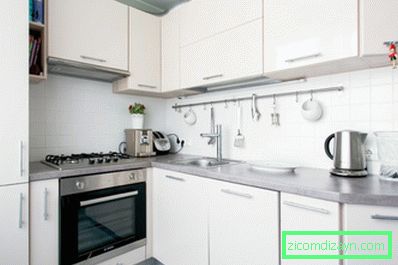
- To choose the most successful format, do not rush to buy material on the first trip to the store. It is best to do the following: first write down in the notebook all the options you liked, indicating the articles, the name of the collection, the manufacturer and - most importantly - the sizes, then at home, slowly work out several styling schemes with selected favorites. Ideally, you should use the service of the store designer.
6. Buy tiles from only one batch and one tone
The fact is that because of the characteristics of the production of ceramics, the same tile (that is, the same article, tone, collection and manufacturer), but produced in different batches, is always slightly different in color. The difference between "multi-party" samples may seem quite insignificant, but in finishing the finished apron will become very noticeable.
- Whether you buy tiles on the market or order delivery in an online store, always check not only the belonging of ceramics to one lot, but also the match in tone (it can be denoted by a numeric or alphabetic code).

7. The tile should match the style and color scheme of the interior
For the kitchen in the classic or rustic style, tiles in the style of majolica or cotto ceramics, stone tiles, metlakh tiles, as well as square small format tiles, for example, 10 × 10 cm,

Apron of square tiles with a frieze in the style of Provence
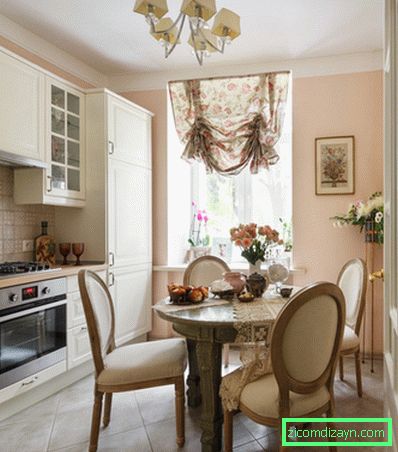
Square tile for majolica in the interior of classical cuisine

For a modern interior, it is better to choose a large-size tile imitating a stone, wood, leather, metal or other interesting texture. A monophonic mosaic, brick tile, black-and-white tile, with geometric pattern or non-standard format, for example, an elongated 10 × 30 cm is ideal.
As for the choice of color and pattern of the apron, there are no strict rules. The main thing is that its design should resonate with other elements of the interior. For example, it can be a countertop, walls, facades, headset or floor (especially if it is tiled). Also, the apron can be decorated in the tone of curtains, wall decor and accessories.

Fragments of this apron in patchwork style echo the pattern of wallpaper
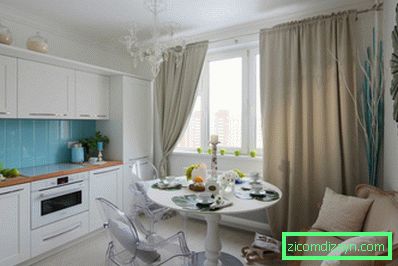
Blue apron kitchens support blue accessories
And one more nuance. The brighter and more colorful the apron, the more neutral the interior should be. And, on the contrary, the kitchen, filled with color, textures and prints is safer to supplement with a quiet apron.
8. Tile format "hog" ("metro") - the most universal solution
Among all the varieties of wall tiles, there is one unbeatable and universal format that fits even in the most conservative or most cutting-edge interiors - the tavern "hog" (the second popular name is "metro").
- The glossy monophonic surface, rectangular shape in size from 7 × 12 cm to 10 × 25 cm and bevelled edge - this is the formula of the classic "wild boar", which will never go out of fashion.

Strictly speaking, tiles "boar" and "metro" are not exactly the same thing. The "metro" format has a size of 7.5 × 15 cm and is executed in white. It is such a tile lined with walls of the Parisian subway, which gave the name to the popular tile
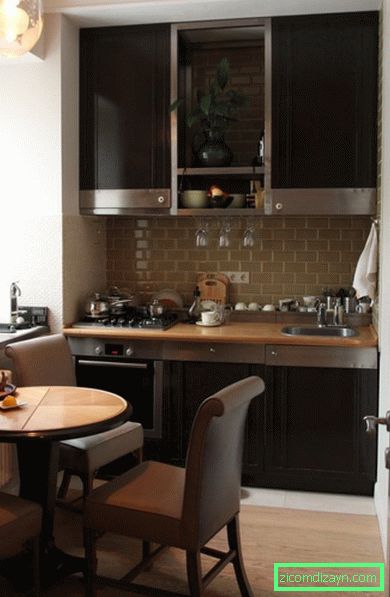
Beige "wild boar" in the interior of classical cuisine

Kabanchik in the modern interior of the kitchen
Most often, the tusk is spread out with a displacement (according to the principle of brickwork), but any other schemes, for example, a herringbone, a seam in the seam, or a runaway can be applied.
 Stacking the hog seam in the seam
Stacking the hog seam in the seam
You can also "play" with the color of the grout.
For more details, see the material: Apron made from tile "boar" in the interior of the kitchen - from choosing the design to laying by your own hands
9. If you can not find a tile of the right size or design, look for it in the floor tile department
Floor ceramic tiles are very durable and resistant to abrasion, so it is great for finishing the apron. But wall tiles for facing the floor is not good, because it does not withstand heavy loads.
- By the way, the flooring is indicated by a badge in the form of a foot, and the wall decoration is represented by a palm.
10. The grout must be, firstly, water resistant, and secondly - suitable in color
The trowel for the tile of the kitchen apron should be water resistant, dirt repellent and antifungal. Also, to protect the tile seams from grease and dirt will help a special impregnation, filling the pores of the grout. For example, it could be Atlas Dolphin or Ceresit CT 10.
11. Select the laying pattern that will correct the imperfections of the room
If your kitchen is small, pare the apron with rectangular tiles and lay their seam in the seam, with a bias, diagonally or "herringbone". Another option is an apron in a horizontal strip. Such a design will help visually expand the space.

Laying a square tile diagonally

Also, a small kitchen can be visually enlarged by giving the space depth, when the apron seems to be in a niche. To create such an effect, it should be darker than the facade of the headset and walls.

A white glossy apron will make the cluttered tight space more spacious and airy, and in the dark kitchen will add light.
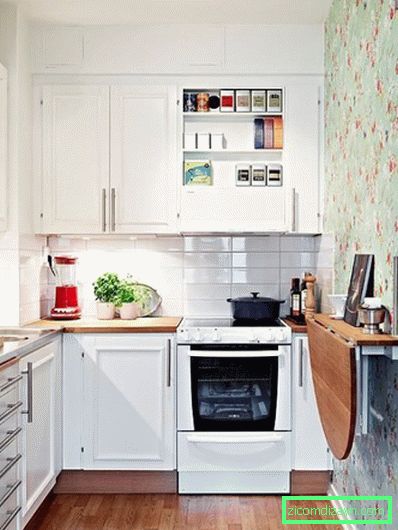
Apron of white glossy tiles in the interior of a small kitchen
What kind of tile does not fit, if the kitchen is small? Try to avoid too variegated designs, if the interior is already filled with bright and self-sufficient details, otherwise the space will become congested and as if cluttered.
If the kitchen has a low ceiling, in the design of the apron it is worth creating more vertical lines. This can be done due to the vertical orientation of the same "Christmas tree" and other layouts, as well as using a tile in a vertical strip, as, for example, in this photo-example.

12. If the desired tile does not fit into the budget, combine expensive material with a more budgetary
Inserts from expensive ceramic tiles or, say, mosaics ennoble ordinary tiles, but do not hit hard on the pocket. In addition, this combination can look very stylish.

Tiles in combination with tiles in the kitchen apron finish
You can also save on the material and create a unique design of the apron, you can buy and combine the tile that is on the leftovers.
Browse Formats
Now let's look at the most popular types of ceramic tiles for an apron.
Tile 10 × 10
This classic tile format is appropriate in any interior, and it's even easier to lay it. In addition, it is in this category that the largest selection of designs is presented.
Tip:
- Especially relevant tile 10 × 10 in case you want to save and clothe an apron.
- To make an apron from simple square tile more stylish the contrasting grout will help.
- The most fashionable 10x10 cm tile is in the style of majolica, which allows you to decorate an apron in the style of patchwork as in this collection of photos.

Kitchen apron in patchwork style
- Often the usual square tiles are decorated with so-called tile-decor.

Apron of tiles with decor
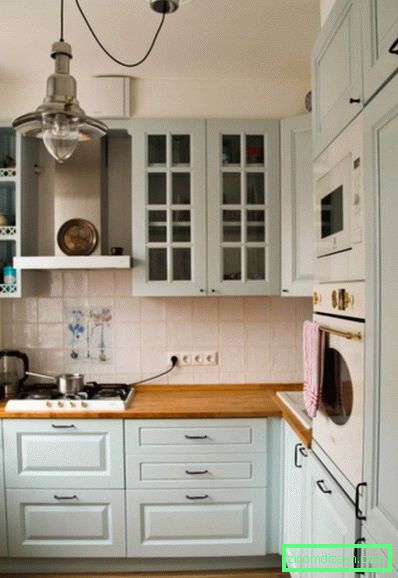
Hog (metro)
About this format, we have already told you before, and now offer a look at photo-examples.
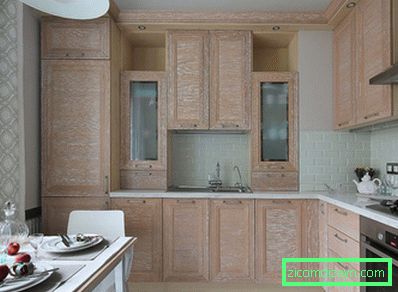
Mosaic
Mosaic хороша тем, что кажется более «ручной» и изящной, кроме того она прочна (за счет небольшого размера чипов) и позволяет отделывать криволинейные поверхности. Однако стоит она в два раза дороже обычного кафеля и требует вдвойне большего расхода затирки. И, конечно, из-за маленького размера чипов, мозаичный фартук имеет больше швов, которые осложняют уход.
Advice:
- Motley mosaic pattern is appropriate only if the kitchen is decorated neutral. If the interior is already filled with bright colors, patterns and prints, it is safer to choose a monophonic mosaic.
- If the budget allows, choose for grouting joints mosaic is not a normal grout, and epoxy. Yes, it costs more and requires more painstaking work, but it is much more durable, beautiful and practical.
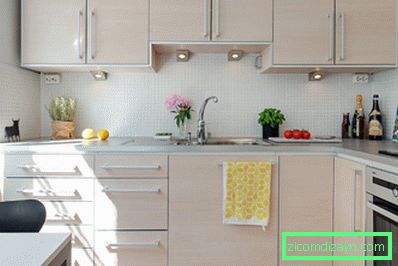

More details in the material: All about the kitchen apron from the mosaic and even more
Metlakh tile
Metlakh tile, строго говоря, не керамическая, а скорее керамо-фарфоровая. Она гораздо прочнее и более износоустойчивая, чем обычная керамика, дороже и многообразнее по формам и расцветкам.
- Hexagons, octagons, circles and squares of various colors and patterns make the apron look like a carpet or a skilful panel.

Advice:
- Most of all, Metlakh tile is appropriate in classical interiors.
- The master-tiler of high qualification must lay the tile of the Metlakh tile.
- Replace it will be able to imitate, as, for example, in this interior.

Majolica (tiles, azulezhu)
Majolica is the same ceramics, but its glaze is painted by hand and only then it is fired at high temperature. As a result, the color of the tile is bright, and the pattern - clear. As a rule, majolica tile is always square.
Advice:
- Most majolica is appropriate in classical and ethnic (especially "Mediterranean") Interiors.
- These tiles are expensive, so they are often replaced by imitations of conventional ceramics or they are made up of only a small area, for example, the area behind the plate.


